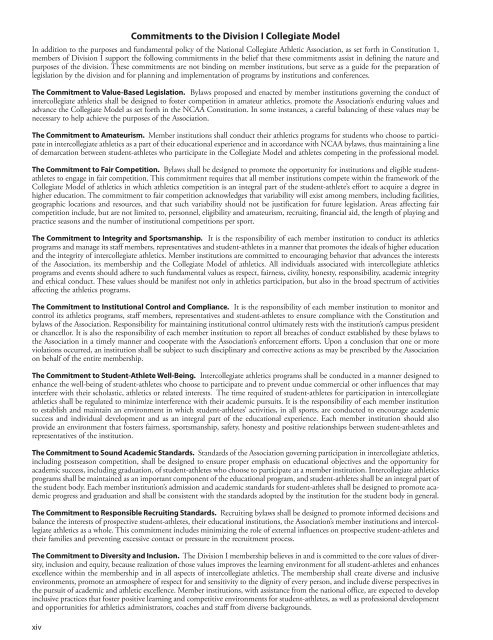ncaa-manual
ncaa-manual
ncaa-manual
- No tags were found...
Create successful ePaper yourself
Turn your PDF publications into a flip-book with our unique Google optimized e-Paper software.
xivCommitments to the Division I Collegiate ModelIn addition to the purposes and fundamental policy of the National Collegiate Athletic Association, as set forth in Constitution 1,members of Division I support the following commitments in the belief that these commitments assist in defining the nature andpurposes of the division. These commitments are not binding on member institutions, but serve as a guide for the preparation oflegislation by the division and for planning and implementation of programs by institutions and conferences.The Commitment to Value-Based Legislation. Bylaws proposed and enacted by member institutions governing the conduct ofintercollegiate athletics shall be designed to foster competition in amateur athletics, promote the Association’s enduring values andadvance the Collegiate Model as set forth in the NCAA Constitution. In some instances, a careful balancing of these values may benecessary to help achieve the purposes of the Association.The Commitment to Amateurism. Member institutions shall conduct their athletics programs for students who choose to participatein intercollegiate athletics as a part of their educational experience and in accordance with NCAA bylaws, thus maintaining a lineof demarcation between student-athletes who participate in the Collegiate Model and athletes competing in the professional model.The Commitment to Fair Competition. Bylaws shall be designed to promote the opportunity for institutions and eligible studentathletesto engage in fair competition. This commitment requires that all member institutions compete within the framework of theCollegiate Model of athletics in which athletics competition is an integral part of the student-athlete’s effort to acquire a degree inhigher education. The commitment to fair competition acknowledges that variability will exist among members, including facilities,geographic locations and resources, and that such variability should not be justification for future legislation. Areas affecting faircompetition include, but are not limited to, personnel, eligibility and amateurism, recruiting, financial aid, the length of playing andpractice seasons and the number of institutional competitions per sport.The Commitment to Integrity and Sportsmanship. It is the responsibility of each member institution to conduct its athleticsprograms and manage its staff members, representatives and student-athletes in a manner that promotes the ideals of higher educationand the integrity of intercollegiate athletics. Member institutions are committed to encouraging behavior that advances the interestsof the Association, its membership and the Collegiate Model of athletics. All individuals associated with intercollegiate athleticsprograms and events should adhere to such fundamental values as respect, fairness, civility, honesty, responsibility, academic integrityand ethical conduct. These values should be manifest not only in athletics participation, but also in the broad spectrum of activitiesaffecting the athletics programs.The Commitment to Institutional Control and Compliance. It is the responsibility of each member institution to monitor andcontrol its athletics programs, staff members, representatives and student-athletes to ensure compliance with the Constitution andbylaws of the Association. Responsibility for maintaining institutional control ultimately rests with the institution’s campus presidentor chancellor. It is also the responsibility of each member institution to report all breaches of conduct established by these bylaws tothe Association in a timely manner and cooperate with the Association’s enforcement efforts. Upon a conclusion that one or moreviolations occurred, an institution shall be subject to such disciplinary and corrective actions as may be prescribed by the Associationon behalf of the entire membership.The Commitment to Student-Athlete Well-Being. Intercollegiate athletics programs shall be conducted in a manner designed toenhance the well-being of student-athletes who choose to participate and to prevent undue commercial or other influences that mayinterfere with their scholastic, athletics or related interests. The time required of student-athletes for participation in intercollegiateathletics shall be regulated to minimize interference with their academic pursuits. It is the responsibility of each member institutionto establish and maintain an environment in which student-athletes’ activities, in all sports, are conducted to encourage academicsuccess and individual development and as an integral part of the educational experience. Each member institution should alsoprovide an environment that fosters fairness, sportsmanship, safety, honesty and positive relationships between student-athletes andrepresentatives of the institution.The Commitment to Sound Academic Standards. Standards of the Association governing participation in intercollegiate athletics,including postseason competition, shall be designed to ensure proper emphasis on educational objectives and the opportunity foracademic success, including graduation, of student-athletes who choose to participate at a member institution. Intercollegiate athleticsprograms shall be maintained as an important component of the educational program, and student-athletes shall be an integral part ofthe student body. Each member institution’s admission and academic standards for student-athletes shall be designed to promote academicprogress and graduation and shall be consistent with the standards adopted by the institution for the student body in general.The Commitment to Responsible Recruiting Standards. Recruiting bylaws shall be designed to promote informed decisions andbalance the interests of prospective student-athletes, their educational institutions, the Association’s member institutions and intercollegiateathletics as a whole. This commitment includes minimizing the role of external influences on prospective student-athletes andtheir families and preventing excessive contact or pressure in the recruitment process.The Commitment to Diversity and Inclusion. The Division I membership believes in and is committed to the core values of diversity,inclusion and equity, because realization of those values improves the learning environment for all student-athletes and enhancesexcellence within the membership and in all aspects of intercollegiate athletics. The membership shall create diverse and inclusiveenvironments, promote an atmosphere of respect for and sensitivity to the dignity of every person, and include diverse perspectives inthe pursuit of academic and athletic excellence. Member institutions, with assistance from the national office, are expected to developinclusive practices that foster positive learning and competitive environments for student-athletes, as well as professional developmentand opportunities for athletics administrators, coaches and staff from diverse backgrounds.


